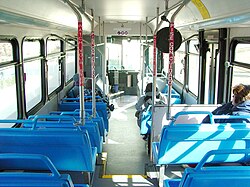Gillig BRT
| Gillig Low Floor | |
|---|---|

A Gillig Low-Floor in service for Harrisonburg Transit in Harrisonburg, Virginia
|
|

Interior view from rear
|
|
| Overview | |
| Manufacturer | Gillig Corporation |
| Also called | Gillig H2000LF Gillig Advantage |
| Production | 1996–present |
| Assembly | Hayward, California |
| Body and chassis | |
| Class | Transit bus |
| Body style | Single-decker bus |
| Doors | 2 doors (1 door Suburban) |
| Floor type | Low entry |
| Chassis | Integral |
| Powertrain | |
| Engine |
Caterpillar
Cummins
Detroit Diesel
|
| Capacity |
*29: 28*35':32*40':40
|
| Transmission |
|
| Dimensions | |
| Wheelbase |
29': 163 in (4,140.2 mm) 35': 235 in (5,969.0 mm) 40' : 284 in (7,213.6 mm) |
| Length | 29–40 ft (8.8–12.2 m) |
| Width | 102 in (2,590.8 mm) |
| Height |
29': 115 in (2,921.0 mm) 35', 40':116 in (2,946.4 mm) |
| Chronology | |
| Predecessor | Gillig Phantom (unofficial) |
The Gillig Low Floor (originally named Gillig H2000LF and also nicknamed Gillig Advantage) is a transit bus manufactured by the Gillig Corporation. The second low-floor bus introduced in the United States (behind the New Flyer LF), the Low Floor has been produced since 1997. Originally produced alongside the Gillig Phantom as an expansion of the transit product range, the Low Floor has become the successor to the Phantom and the sole Gillig bus platform since 2008.
The Gillig Low Floor is assembled in Hayward, California.
The Gillig Low Floor began life in the mid-1990s as Gillig was approached by Hertz Corporation to develop a shuttle bus for its rental car parking lots at airports to replace its aging GMC RTS buses. Featuring a carpeted interior, luggage racks, and a central entry door, the primary design requirement of Hertz was a low-floor entry (for those carrying luggage and with limited mobility). In 1996, the first buses for Hertz (named the Gillig H2000LF) entered production. Gillig would produce the H2000LF for Hertz through 2005, as the design was replaced by standard Gillig Low Floor buses.
In 1997, Gillig modified the H2000LF design for use as a transit bus, adding dual entry doors with no front entrance. The non-Hertz buses were named the Gillig Low Floor, introduced alongside the step-entrance Gillig Phantom.
During its production, the Gillig Low Floor has seen revisions to its body design. In 2002, the windshield was enlarged (along with the use of a smaller destination sign) and the side windows were reduced in width. In 2008, the glass of both entry doors were enlarged (distinguished by squared-off corners). A suburban configuration was added, externally identified by the lack of a rear entry door. In place of transit seating, the configurationris equipped with forward-facing seating, internal luggage racks, onboard Wi-Fi, and other passenger-related options.
...
Wikipedia
